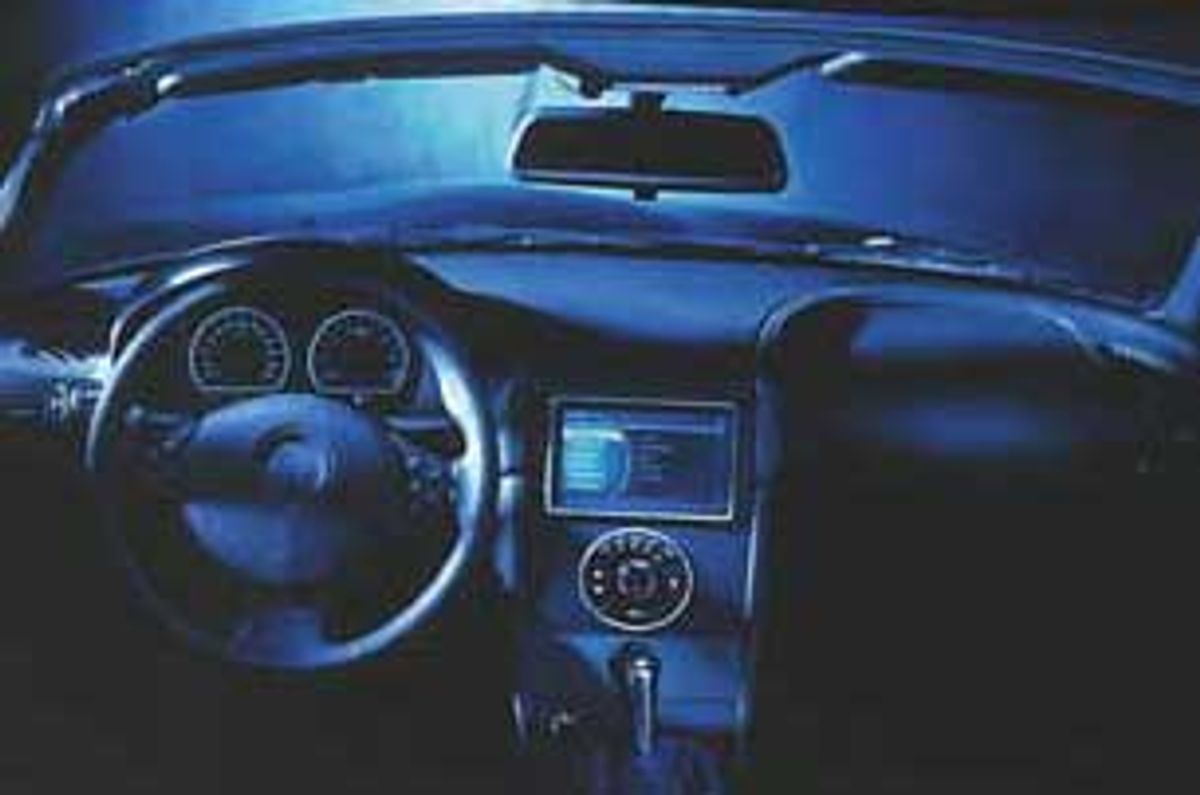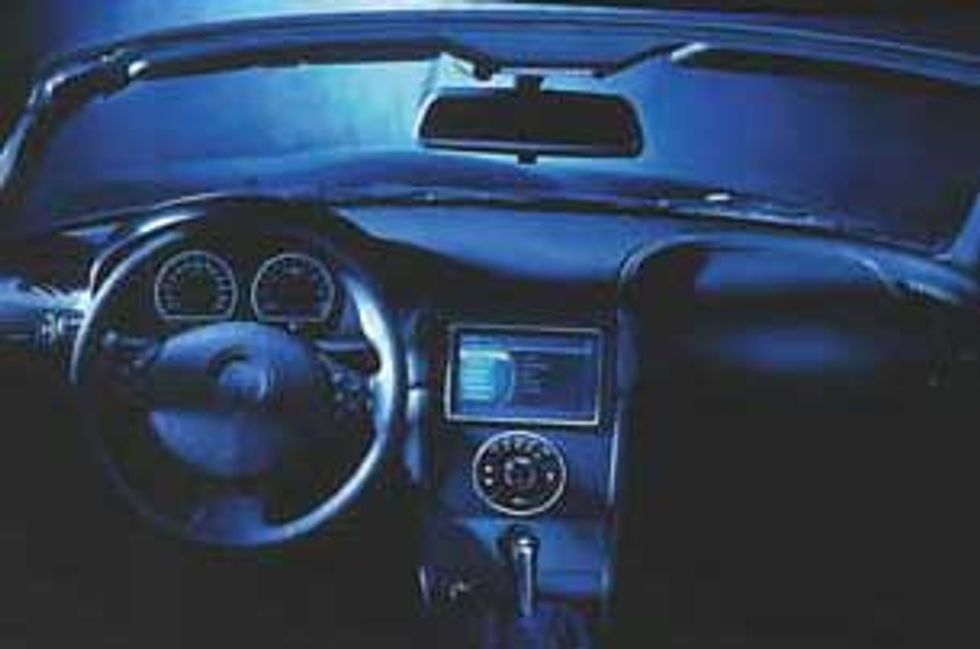The Car: Just a Web Browser with Tires
Automakers are convinced that what consumers really want in a car is safe Web access, which calls for voice-activated control

This is part of IEEE Spectrum's special report: Always On: Living in a Networked World.
To quote the head of Sun Microsystems Inc., of Palo Alto, Calif., Scott McNealy, speaking at a recent automotive electronics meeting, "Why not think of everything as just an Internet node? So a car is just a [Web] browser with tires."
Which is exactly what automakers are thinking as they work at equipping vehicles with not only Internet access but also such services as on-demand emergency assistance, navigation, and traffic reports. To provide access to these services and the hardware needed to deliver them, software developers and automotive electronics engineers are collaborating on voice recognition and speech synthesis interfaces. Everyone agrees, it seems, that by using speech to control equipment, distractions will be minimal and drivers can keep their hands and eyes devoted to the wheel and the road.
For rear seat passengers, where distraction is a plus if it prevents the plaintive "Are we there yet?," automobile manufacturers aim to supply Internet access, and entertainment delivered by DVD, CD-ROM, or the Internet, depending on quality desired for whatever content is delivered. For example, at current cellular phone connection speeds to the Internet, a movie would look herky-jerky, but a movie delivered by a DVD player in the trunk, say, would be as smooth as when watched at home.
Most major vehicle manufacturers worldwide agree that the vehicle will be connected to the Internet. Popular demand is the key. One ultimate application is all it will really take for consumers to insist on Internet connectivity in their cars, IEEE Spectrum was told by Robert LeFort, vice president of Infineon Technologies Corp.'s Automotive Group, in Northville, Mich. "But what is that app? Will it be plug-and-play connectivity in the car for a cell phone plus a PDA [personal digital assistant] to give the driver e-mail and phone lists through his PDA contact list? A combination of Bluetooth and PDA capabilities?"
(Bluetooth is an open standard for wireless transmission of voice and data between devices up to 10 meters apart developed by the Bluetooth Special Interest Group [https://www.bluetooth.com], which was founded in 1998 by Ericsson, IBM, Intel, Nokia, and Toshiba.)
Giant leap to communications
According to automotive industry analysts, the logical starting point for Internet access is found in many cars of recent vintage, the existing analog communication. It currently focuses on emergency assistance and navigation, but is expected to provide other telematics services soon. Telematics is the convergence of telecommunications and information processing in the car, which in essence puts in a two-way information exchange between those inside the vehicle and the world outside [see "Telematics to the Rescue,"]. Once that is available, can the Internet be far behind? Not if carmakers have their way.
The first requirement, however, is a communications connection to the car speedier than the current analog cellular service for telematics. What carmakers and service suppliers are searching for is the communications medium--digital cellular, Bluetooth, satellite, direct short-range radio, standard FM radio, digital radio, something new, or some combination--that will deliver the level of connectivity for which consumers are willing to pay on a subscription basis.
Then it's a question of which applications consumers will want to take from their homes and offices and integrate seamlessly into their cars. The PDA is the likely answer, because it offers the ability to plug-and-play into car, home, or office computing networks with little effort and no setup beyond installation. A driver could simply plug the PDA into a special cradle to link the PDA's contents and applications to the car's communications medium.
For now, communications between the car, or its driver, and any network are handled mainly by cellular phone or, in the case of diagnostics, direct connection to a computer in the repair shop. But so much has been made of Bluetooth and its ability to link appliances wirelessly that car component makers are working double-time to develop Bluetooth-enabled cars.
As several vendors explained it to Spectrum, "This is the scenario we are all driving toward: your Bluetooth-equipped PDA is in your jacket in the trunk of the car, but it has the phone number you need to make a call requesting an e-mail address for an urgent time-critical memo you must send from the PDA. You speak to the Bluetooth-enabled cell phone lying on the seat beside you and request the number. The phone retrieves the number and, on request, dials it for you. It then mutes the Duke Ellington CD playing on the car stereo system to free up the audio system's Bluetooth connection for your phone call. You get the needed e-mail address and enter it orally into your PDA through its Bluetooth connection to the cell phone. The same Bluetooth connections allow you to address the e-mail, attach the memo, and send it from your PDA."
Small step to the Internet
Once the communications tangle is solved, the speedy connection between car and Internet surely will follow. Consumers are expected to want that connection to conduct on-line banking and shopping, primarily. A global study by Roland Berger Strategy Consultants, Troy, Mich., predicts that banking and shopping will account for the greatest share of Internet applications used in the car. The idea is that people will handle chores like bill paying and shopping through on-line banking and catalog providers. "Consumer demand will lead to some kind of e-vehicle Wonderland by 2004, where the choices of services will be huge," explained Michael M. Heidingsfelder, partner and executive vice president at Roland Berger. But success hinges on "the perfection of the human-machine interface in vehicles." Being able to talk to the car to establish an Internet connection, then to log on to your checking account securely to authorize payment to the electric company after double-checking your bill through the utility's Web site, for example, will make the whole thing feasible, Heidingsfelder noted.
Talking to your car
Still, drivers can hardly take their eyes off the road or hands off the steering wheel to shop or bank on-line. The display must be read to the driver, and the driver's commands effected by converting speech to text or clicks. This is the next hurdle facing the automotive industry as it puts the Net in the car.
Space constraints, among other ergonomic and safety issues, prevent carmakers from adding a computer screen and mouse to the sea of displays, buttons, dials, knobs, and controls that already sprawls from the driver's door panel across the dashboard and onto the center console.
Several companies are working on transforming the cockpit into an elegant and simplified panel of displays and controls, among them software company CAA AG of Filderstadt, Germany. In a demonstration BMW Z3 roadster, CAA has basically ignored the dashboard instrument cluster (speedometer, tachometer, and water and engine temperature monitors) in favor of the center console, where the usual audio and ventilation controls have given way to a sleek display and unified central control for menus accessible by voice command, as well.
As Raimund Land, project manager for software development at CAA, told Spectrum, "The interface must be straightforward to let the driver focus on the road. Voice commands enable that."
The display presents everything from the CD track playing to e-mail messages. It also shows submenus behind the one-button access to Media (radio and CD), Telephone (call lists), Navigation (driving directions, nearby parking lots, for example), Comfort (seat position, air conditioning, and in-seat heaters), and Online (Internet and e-mail) menus. The driver's voice can operate the system, which can talk back to guide the driver through the task at hand. At other times, a central knob dials through options within the menus; pushing it makes a selection as a mouse click would.
Component makers are working overtime to develop Bluetooth-enabled cars
Legislation affecting the use of cellular telephones in moving vehicles may speed the development both of voice recognition interfaces and of such a streamlined and simplified cockpit. Portugal has banned cell phone use while driving, and most of the western European nations enforce hands-free use of cell phones while driving. Several municipalities and regional authorities in the United States have also mandated hands-free kits for cell-phone use by drivers. In fact, voice-activated dialing is a feature on many of those kits.
The general industry thinking is that voice control of one appliance, the cell phone, will render it legal for other appliances, including Internet access. Display systems may be a component, but ultimately speech is seen as the key to keeping a driver's eyes on the road and both hands on the wheel.
Users will talk their way through requests for directions to the nearest fuel station from their telematics service provider, say, or to place a phone call to the office, or download e-mail. Telematics service providers will speak to car occupants using the built-in cellular connection to the car, as they do now.
The not-fully-developed portion of voice-based control actuation may just be the ability of the software algorithms in the car to convert text to speech (to read aloud e-mail or other non-preset items to the driver) and speech to text (to take e-mail as dictation, for example). Further complicating these efforts is the electronics' ability to recognize speech and respond with speech of its own, even in a convertible or other noisy car. Everyone in the automotive industry is working on this problem, either directly or through alliances.
Speech recognition specialist Temic Telefunken microelectronic GmbH, Nuremburg, Germany, supplied Mercedes-Benz with its first speech-controlled system for audio systems in its E- and S-class sedans in 1996. According to Mathias Gollwitzer, director of speech processing, Temic is within two years of supplying speech applications for a noisy car environment; a speaker in such an environment will be given dynamic (on the fly) data access to the Internet through sophisticated speech algorithms resident on a remote server.
Temic is contributing its speech recognition abilities to the MobileGT platform of Motorola Inc., Schaumburg, Ill. The aim is to produce a modular computing platform that "ensures scalable automotive customization and offers an open architecture for a range of products focused on driver information systems," explained Scott Anderson, vice president and general manager of Motorola's Transportation Systems Group, Austin, Texas.
The scalable Java-based architecture will allow automakers to develop products and applications as desired, and specific to certain classes of cars. Thus a luxury automobile might offer everything through its MobileGT-based system--navigation; wireless connectivity for communications, traffic updates, and Internet access; natural language speech processing; car audio; virtual dashboards; and multimedia (radio, DVD, and CD)--whereas an economy car might offer only two or three items.



